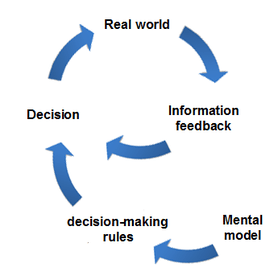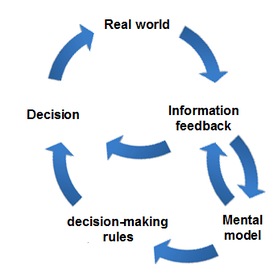Double-loop learning
Double-loop learning entails the modification of goals or decision-making rules in the light of experience. The first loop uses the goals or decision-making rules, the second loop enables their modification, hence "double-loop". Double-loop learning recognises that the way a problem is defined and solved can be a source of the problem.[1]
Detail
Double-loop learning is contrasted with "single-loop learning": the repeated attempt at the same problem, with no variation of method and without ever questioning the goal. Chris Argyris described the distinction between single-loop and double-loop learning using the following analogy:
[A] thermostat that automatically turns on the heat whenever the temperature in a room drops below 68°F is a good example of single-loop learning. A thermostat that could ask, "why am I set to 68°F?" and then explore whether or not some other temperature might more economically achieve the goal of heating the room would be engaged in double-loop learning
Double-loop learning is used when it is necessary to change the mental model on which a decision depends. Unlike single loops, this model includes a shift in understanding, from simple and static to broader and more dynamic, such as taking into account the changes in the surroundings and the need for expression changes in mental models.[2]
- Reference models I and II
 Single-loop learning
Single-loop learning Double-loop learning
Double-loop learning
Historical precursors
A Behavioral Theory of the Firm (1963) describes how organizations learn, using (what would now be described as) double-loop learning:
An organization ... changes its behavior in response to short-run feedback from the environment according to some fairly well-defined rules. It changes rules in response to longer-run feedback according to more general rules, and so on.
See also
References
- 1 2 Argyris, Chris (May 1991). "Teaching smart people how to learn" (PDF). Harvard Business Review. 69 (3): 99–109. Retrieved 22 November 2015.
- ↑ Mildeova, S., Vojtko V. (2003). Systémová dynamika (in Czech). Prague: Oeconomica. pp. 19–24. ISBN 80-245-0626-2.
- ↑ Cyert R.M.; March J.G (1963). A Behavioral Theory of the Firm. New Jersey: Prentice-Hall. pp. 101–102.
- ↑ Quote taken from p. 9 of The Blackwell Handbook of Organizational Learning and Knowledge Management (2003) which describes this quote as "an early version of the distinction between single and double-loop learning." and refers to the 1963 edition.
Further reading
- Bassot, Barbara (2015). "Bringing assumptions to the surface". The reflective practice guide: an interdisciplinary approach to critical reflection. Abingdon; New York: Routledge. pp. 79–92. ISBN 9781138784307. OCLC 898925915.
- Bochman, David J.; Kroth, Michael (2010). "Immunity to transformational learning and change". The Learning Organization: An International Journal. 17 (4): 328–342. doi:10.1108/09696471011043090.
- Fraser, J. Scott; Solovey, Andrew D. (2007). Second-order change in psychotherapy: the golden thread that unifies effective treatments. Washington, DC: American Psychological Association. ISBN 1591474361. OCLC 65195322.
- Brockbank, Anne; McGill, Ian (2012) [2006]. "Single and double loop learning". Facilitating reflective learning: coaching, mentoring and supervision (2nd ed.). London; Philadelphia: Kogan Page. pp. 22–26. ISBN 9780749465070. OCLC 769289635.
- Argyris, Chris (2005). "Double-loop learning in organizations: a theory of action perspective". In Smith, Ken G.; Hitt, Michael A. Great minds in management: the process of theory development. Oxford; New York: Oxford University Press. pp. 261–279. ISBN 0199276811. OCLC 60418039.
- Blackman, Deborah; Connelly, James; Henderson, Steven (January 2004). "Does double loop learning create reliable knowledge?" (PDF). The Learning Organization: An International Journal. 11 (1): 11–27. doi:10.1108/09696470410515706.
- Torbert, William R.; Cook-Greuter, Susanne R.; Fisher, Dalmar; Foldy, Erica; Gauthier, Alain; Keeley, Jackie; Rooke, David; Ross, Sara Nora; Royce, Catherine; Rudolph, Jenny (2004). Action inquiry: the secret of timely and transforming leadership. San Francisco: Berrett-Koehler. ISBN 157675264X. OCLC 53793296.
- Smith, Mark K. (2013) [2001]. "Chris Argyris: theories of action, double-loop learning and organizational learning". infed.org. Retrieved 2016-03-19.
- Nielsen, Richard P. (1996). "Double-loop, dialogue methods". The politics of ethics: methods for acting, learning, and sometimes fighting with others in addressing ethics problems in organizational life. New York: Oxford University Press. pp. 75–105. ISBN 0195096657. OCLC 34517566.
- Argyris, Chris (1999) [1993]. On organizational learning (2nd ed.). Oxford; Malden, MA: Blackwell Business. ISBN 0631213082. OCLC 40460132.
- Isaacs, William N. (September 1993). "Taking flight: dialogue, collective thinking, and organizational learning" (PDF). Organizational Dynamics. 22 (2): 24–39. doi:10.1016/0090-2616(93)90051-2.
- Argyris, Chris (1980). Inner contradictions of rigorous research. Organizational and occupational psychology. New York: Academic Press. ISBN 0120601508. OCLC 6421943.
- Argyris, Chris; Schön, Donald A. (1978). Organizational learning: a theory of action perspective. Reading, MA: Addison-Wesley. ISBN 0201001748. OCLC 394956102.
- Argyris, Chris (September 1976). "Single-loop and double-loop models in research on decision making". Administrative Science Quarterly. 21 (3): 363–375. doi:10.2307/2391848. JSTOR 2391848.